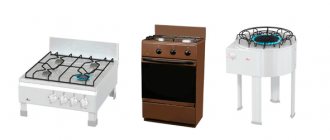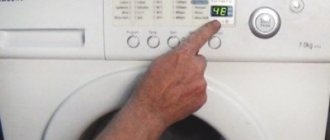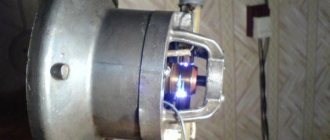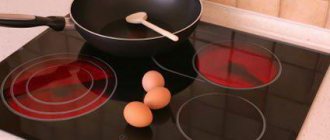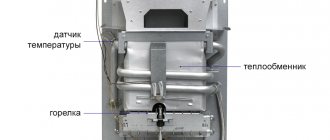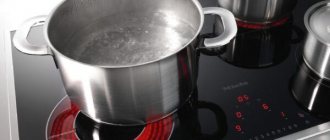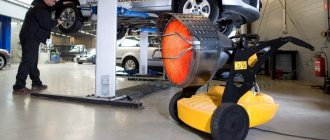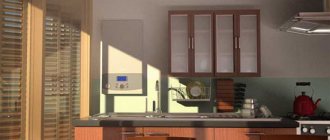Most of the operations discussed below are not recommended to be done on your own - simply prohibited. Compiles the work of gas service employees. You will be surprised: why provide information. Practice shows: there are people who want to make a spaceship with their own hands. To prevent anything from happening in the process, here is a thematic overview of the heavenly summers... that is, gas equipment. Do not consider it as a guide or instruction. A warning to those who decide to secretly find out why a gas stove smokes. Without calling the experts, he began to fight the problem. To prevent more troubles, read a couple of pages carefully. Soot from a gas stove... Let's try to figure it out...
Another master is like a hurricane. One took 600 rubles, simultaneously breaking the float of the toilet barrel in order to finalize the developer’s deficiencies. The second hooves pricked the tiles that were waiting to be grouted. (I was warned when I broke it - I blinked my eyes, asking: what is that crack?) Choose a master carefully.
Tales about gas and gas stoves
The stove is smoking, if something happens at the dacha, you have to call the service technicians. Specialists refuse to work on weekends and holidays; they need to cook urgently now; here is a brief overview of the problem of smoking stoves.
The gas stove smokes - there are two reasons:
- The gas contains excess sulfur impurities, which produces thick black smoke.
- The gas pressure is abnormal. Exceeds the nominal value of the plate and injectors. Residential main line pressure is low. By default, household appliances are designed to work in these conditions. More often, the problem terrorizes summer residents who connect their home gas stove to a purchased cylinder.
Why does a gas oven smoke?
The reasons for smoking burners of burners and ovens can be similar, but also radically different. The most common of them are:
- The pressure in the cylinder or line exceeds the permissible limit (according to the technical specifications).
- Foreign sulfur additives make the gas composition of poor quality; after its combustion, traces of soot remain on the pans.
- Lack of necessary settings. New models require complex adjustments depending on many parameters. It’s not easy to do it yourself; you often need the help of specialists.
- Clogged jets. The design of the oven is much more complex due to the design of the burners, so it is better to call a professional to clean its elements.
- Poor quality burners. Cheap models are made from low-quality materials that have a minimal service life. Therefore, over time, the heating elements begin to work intermittently. In such cases, smoking often appears. To fix the problem, you only need to promptly replace the damaged parts.
If the oven suddenly starts smoking, you should immediately stop using it. Such a malfunction in the oven can spoil the quality of food and lead to food poisoning.
If a gas oven smokes, then it is dangerous to use it for cooking; it needs to be repaired urgently Source nikolaev-remont.com.ua
Poor quality gas cylinder
Bottled gas contains sulfur impurities - the summer resident is free to complain to Rospotrebnadzor and other supervisory and monitoring organizations. He will provide a fuel receipt, a gas cylinder for analysis, and write a statement. Before the enterprise, make an attempt to complete the matter peacefully; the conditions of Russian reality increase the chance of confrontations.
The gas stove smokes - the contents of the cylinder are of poor quality. Let's work out the algorithm:
- You will have to resign yourself to swallowing the fact or try to relocate the cylinder, stove, where the soot is powerless to cause damage to property.
- Later we will contact the organization that filled the cylinder to explain the issue of excess sulfur.
- Seeing the seller’s lack of understanding of the situation, we complain, trying to restore justice.
If you have friends who have purchased gas from the organization, inquire in a friendly manner whether the gas stove smokes. One head is good, two are better. It is much more pleasant to while away the time with a friendly conversation than to silently wait in line.
When raising the alarm by blaming the gas supplier, read the review first. Perhaps the reason is limited to incorrect settings of gas equipment.
Why does the gas stove at the dacha begin to smoke?
Many people are faced with the question of why a gas stove in the country smokes when connecting cylinders. Mostly the models of this equipment are designed to work with main gas. Therefore, the injectors have large through holes, which are not suitable for high pressure LPG.
Fixing the problem of a gas stove with a propane tank smoking is quite simple. To do this, you will need to purchase a new nozzle (nozzle) or reduce the holes on the existing device. If the parts are selected correctly, but the stove still smokes, you may need to clean them. To do this, follow the algorithm:
- Close the gas access by tightening the valve.
- Remove the top panel of the stove.
- Locate the nozzles located under the burners.
- Unscrew them using the key.
- Clean all holes with a needle or knitting needle.
- Sand the top surface with sandpaper.
- Clean the chamfer of the hole.
Cleaning the gas stove nozzle
When removing carbon deposits and grease from surfaces, do not forget to clean the divider covers, since a large amount of various contaminants accumulate on them.
When installing a new jet, extreme care must be taken as gas may explode if installed incorrectly.
The gas stove is not set up correctly
Required by a special service. The gas stove burner smokes - the inlet pressure is too high. Bottled gas in a highly compressed state cannot be compared with the blue fuel supply line for residential buildings.
Internal structure of the burner
Avoiding fainting, considering the idea of getting inside the burner so as not to spoil anything inside, study the following information.
Excluding old stoves from Soviet times, considering modern kitchen equipment - electric models are supplied with replaceable jets in two sets. The burners are composed of the following main parts:
- The divider is a part of the form of a flange sleeve, cut with tower teeth along the perimeter, through which the gas is distributed evenly in a circle.
- Divider cover. The divider is covered on top with a round plate. Made from stainless steel, many options are available today. Doesn't play a role.
Sometimes the design is complemented by an electric spark plug protruding from the side of the divider. The spark acts like the ignition of an ordinary car. Electricity ignites blue fuel. There is a temperature sensor near the spark plug. Externally similar, a person seeing the design for the first time will confuse the two elements. The sensor helps the stove understand whether the gas is burning. Goes out - a special electromagnetic valve shuts off the fuel supply, excluding a fire.
If you take out the divider and the cover, you will find the jet. A small bolt with a through axial hole. Bypassing the nozzle head, the gas enters the divider and then burns. The stove is smoking - the hole is too large. You will notice a small hole with a diameter of a millimeter on the nozzle. The part is yellowish in color, made of brass, bronze of a similar alloy. The quality of the jet and the correct installation ensure the safety of those living next to a smoking gas stove; we carefully consider the pitfalls step by step.
The stove smokes, reasons
@lenbyt.ru
The factor leading to smoking can be indicated by the nature of its manifestation:
- One burner is smoking - most likely, the nozzle is clogged or deformed, or its diameter does not match the size of the burner. Similar violations are sometimes observed with a flame divider.
- All the burners are malfunctioning - the gas is supplied under too high pressure and does not have time to completely burn out, this often happens with a cylinder connection, and occasionally in central gas supply systems. In the second case, it makes sense to find out how your neighbors’ gas stoves work and, if similar violations are identified, jointly contact the gas service.
- A less common problem is poor regulation of the air flow coming into contact with the flame. It is not recommended to configure this setting yourself. It is extremely rare that the cause of smoking of a gas stove is the poor quality of the fuel itself, namely the content of a large amount of sulfur. Typically, such violations are random and isolated; the quality of the gas mixture is strictly monitored by suppliers.
Modification of the smoking plate jet
A modern gas stove is equipped with two sets of jets, two sets are attached. The manufacturer is aware of the problem: the equipment smokes when switching from main gas to bottled gas. The kit is completed with a socket wrench and two types of jets. Provide your garden equipment with smaller holes (0.8 mm).
Please note: the jet will enter crookedly, it will begin to bleed gas to the side, and household members will have a chance to fly into the air. Only a person with straight arms and sharp eyesight is able to perform an operation, avoiding harm with a probability so high that he does not have to worry about the consequences.
There is no second set of jets, there is no way to buy them - you will have to modify the improvised ones. We remind you that this is not a guide, but safety advice for those who refuse to invite gas workers. You will need a soldering iron, solder, a set of sewing needles, and a couple of hours of time.
First of all, the brass is deprived of its oxide film, the solder will sit securely on the metal. Stop rushing with the rosin: take some alcohol and carefully wipe the nozzle with clean hands. After the hole, the cap is rosinized, the oxide film is peeled off, a drop of solder is applied, and the tin will enter the hole.
The drop is sanded down flush with the cap. It's time for the needles. We take a small one and pierce a hole, then a second, larger one. We bring the diameter of the hole to 0.5 mm (you can measure the diameter of the needle with a caliper), try to screw the jet back. The flame is blue, devoid of a single yellow tongue, confident, not smoky. The result corresponds to the description of a normal flame - take the second jet.
The first time is rarely successful. We take out the jet and use a set of needles to widen the hole. Every 0.1 mm we try the result. Please note: the hole is strictly parallel to the axis of the nozzle so that it stands vertically in the gas stove. Failure to comply will result in the release of blue fuel and an explosion will occur. At first, the gas stove, equipped with new jets, was tyrannized by continuous supervision.
How to fix the problem
@kvobzor.ru
If the nozzles are dirty, it is enough to rinse the stove thoroughly, first turning off the gas supply and waiting for the device to cool completely:
- Remove the grill and flame breakers, if necessary, remove any stuck or burnt pieces of food, then immerse in a warm detergent solution and leave for 15–20 minutes.
- Clean clogged nozzle holes with a long needle or a piece of metal wire of suitable diameter. All actions should be performed without pressure, delicately.
- Rinse all elements under running water, dry, and install in their original place without distortion. Make sure that all protrusions of the parts match.
If cleaning does not bring results, you should pay attention to the diameter of the nozzle; it is indicated in millimeters with special markings and must match the size of the nozzle. If any discrepancies are found, you can carefully replace the injectors. It is important to screw them strictly perpendicular to the surface of the slab.
The air supply is regulated by air discs; you need to slightly tighten the locking pin (the location of the parts is indicated in the instructions for the device). If the action is performed correctly, the flame will burn silently and its height will not exceed 25 mm.
If you discover deformation of the old parts of the stove, you should replace them with new ones; correcting and repairing elements of gas equipment for further operation is dangerous.
Why does a gas stove leak gas?
Gas stoves consist of many tubes and assemblies. Any threaded connections will lose their tightness over time and some fuel will leak through them. The functionality of modern stoves protects against many unpleasant moments, but even they allow gas to pass through. If you regularly use household tools, you can eliminate the leak effectively and relatively quickly.
A traditional gas stove has a hob with burners, control knobs, a grate, a lid and an oven. The operation of equipment is affected by correct installation, parts, and build quality. Due to breakdowns and problems with equipment, gas may partially escape.
A gas stove consists of a hob with burners, an adjustment panel with handles and an oven, and the gas enters the appliance through a supply pipe
The owner should find out where exactly:
- through the burners and their nuts;
- handles that control the burners;
- gas stove shut-off valve;
- hose or its connection point;
- internal elements.
Unauthorized installation of slabs, which is prohibited by safety rules, leads to problems. For older gas stoves, some insulation failure is normal. It is better to replace or repair the equipment through a service center. A faulty stove cannot be left unattended while it is on. You can rely on built-in protection, but only for a short time.
Consumers experience leaks if there is not enough lubricant in the valve plug or the valve itself is loose. Nuts often loosen and seals wear out. Solving such difficulties can be difficult, but internal breakdowns also cause great difficulties.
A faulty burner is simply stopped being used if it is not possible to repair or replace it with a new one. Gas escapes through the burners when the stove is used inappropriately. For example, if liquefied gas is supplied to the device under the gas network.
If the stove is powered by bottled gas
As a rule, there are two main reasons for the formation of soot in a gas stove. The first is the sulfur impurities that the gas cylinder contains. As you know, when this substance burns, it produces acrid black smoke. This is what owners see when using low-quality gas.
If you have replaced the cylinder, but the stove continues to cause inconvenience, pay attention to the pressure level. It happens that it exceeds the indicators that were included in the slab during development. This is due to low gas pressure in the pipelines of residential buildings, which household appliances are designed to work with. Attempts to connect a simple home stove to a gas cylinder can cause internal problems, which result in the appearance of soot.
Gas impurities
So, if you find yourself in a situation where soot appears due to the impurities contained in the cylinder, there is no need to panic. It is necessary to carry out the following manipulations.
- Move the household appliance to a more suitable room, where the property will not suffer as much damage. The smartest solution would be to temporarily stop using the stove, but in reality this may cause problems. Most people may simply not have an alternative way to prepare food.
- Having resolved the issue with the location, you need to contact the supplier company for an explanation. The seller must exchange the defective product or compensate for losses.
- In case of refusal by the supplier, you can send a complaint to the control authorities.
If the seller of gas cylinders turns out to be unscrupulous, the deceived buyer can contact Rospotrebnadzor or any other supervisory authorities.
Gas pressure problems
You shouldn’t get excited and throw accusations; the problem can arise for other reasons. Carefully inspect your device for internal faults: it may not be designed to work with cylinders. This information can be found in the instructions for the equipment. The main part of the stoves is designed to be connected to the mains of a residential building, so excessively high gas pressure can cause the burner to smoke.
